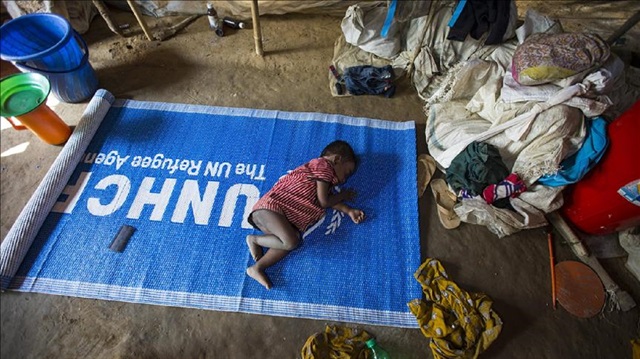

File Photo: A child sleeps on an United Nations High Commissioner for Refugees (UNHFR) mat on the floor at a refugee camp in Cox's Bazar, Bangladesh on December 27, 2017. Rohingya Muslims live in makeshift tents made of bamboo, mud-brick and plastic.
Half a million Rohingya refugee children at risk in overcrowded camps in Bangladesh with storm season looming, warns UNICEF
UNICEF on Tuesday warned of overcrowded refugee camps in Bangladesh which could lead to devastating disease outbreaks, displacement, and death for more than half a million Rohingya refugee children ahead of the upcoming cyclone and monsoon seasons.
"The health and safety of more than 520,000 Rohingya children living in overcrowded camps and informal settlements in Bangladesh is likely to be put at even greater risk ahead of upcoming cyclone and monsoon seasons," the UN agency said on Tuesday.
"As we get closer to the cyclone and monsoon seasons, what is already a dire humanitarian situation risks becoming a catastrophe. Hundreds of thousands of children are already living in horrific conditions, and they will face an even greater risk of disease, flooding, landslides and further displacement," Edouard Beigbeder, UNICEF representative in Bangladesh, said in a statement.
More than 4,000 suspected cases of diphtheria have been reported among the Rohingya refugees in Bangladesh, with a total of 32 deaths, including at least 24 children, said UNICEF.
"In addition to the increased threat of disease outbreaks, the cyclone season brings an increased risk of flooding and landslides, a direct risk to children’s lives. Even a moderate storm could have a devastating impact, with little time to prepare ahead of the start of the cyclone season in March," UNICEF warned.
Tropical cyclones generally strike Bangladesh in two seasons, March through July and September through December, with the greatest number of storms arriving in May and October. Last May, Cyclone Mora barreled through the region, destroying approximately one-quarter of the makeshift shelters in Rohingya refugee camps and causing widespread damage.
Child malnutrition
The World Food Program (WFP) also highlighted the concerns about food insecurity and undernutrition in Rakhine state in bordering Myanmar -- home to a large Rohingya population -- especially for the health of women and children.
"Child malnutrition rates in Maungdaw and Buthidaung townships (northern Rakhine State) were already above emergency thresholds before the recent violence," the WFP said in a statement.
On Monday’s meeting of a Bangladesh-Myanmar Joint Working Group on the return of refugees who have been arriving from Rakhine into Bangladesh since Aug. 25, the UN refugee agency UNHCR said it "underscores the importance of the dialogue between the two states at the core of which is the right of refugees to voluntarily return home."
"To ensure that the refugees are heard and their protection guaranteed in Bangladesh and on return in Myanmar, we are willing to be part of these discussions," the UNHCR said.
The agency called on Myanmar authorities to provide "urgent, unhindered access in Rakhine state, in order to assess the situation and provide support to those in need who are still in Rakhine and to help with rebuilding efforts."
"While a few agencies have regained limited access in the northern part of Rakhine state, UNHCR staff are not currently authorized to travel outside Maungdaw town," the UNHCR said.
"Before considering return to Myanmar, some Rohingya refugees in Bangladesh have informed UNHCR staff that they would need to see positive developments in relation to their legal status and citizenship, the security situation in Rakhine state, and their ability to enjoy basic rights back home," it said.
Fleeing Myanmar army crackdown
The Rohingya, described by the UN as the world's most persecuted people, have faced heightened fears of attack since dozens were killed in communal violence in 2012.
Since Aug. 25, 2017, some 650,000 refugees, mostly children and women, fled Myanmar when Myanmar forces launched a crackdown on the minority Muslim community, according to the UN. At least 9,000 Rohingya were killed in Rakhine from Aug. 25 to Sept. 24, according to Doctors Without Borders.
In a report published on Dec. 12, the global humanitarian organization said that the deaths of 71.7 percent or 6,700 Rohingya were caused by violence. They include 730 children below the age of 5.
The UN has documented mass gang rapes, killings -- including of infants and young children -- brutal beatings, and disappearances committed by security personnel. In a report, UN investigators said such violations may have constituted crimes against humanity.
#Rohingya
#Myanmar
#UN



